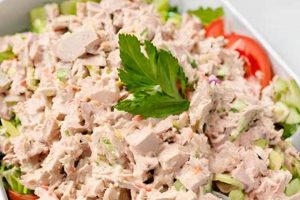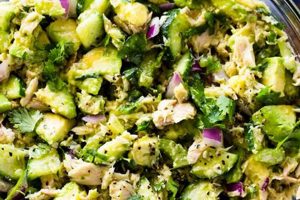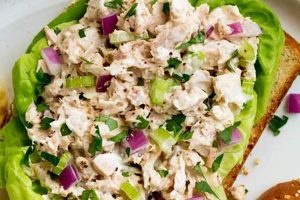A classic New York delicatessen tuna salad typically combines canned tuna with mayonnaise, celery, red onion, and seasonings. Variations might include hard-boiled eggs, pickles, or relish. This simple combination of ingredients creates a flavorful and affordable meal, often served on rye bread or a roll, as a sandwich, or as part of a salad plate.
This style of tuna salad represents a culinary tradition, reflecting the city’s history as a melting pot of cultures. Its accessibility and adaptability have contributed to its enduring popularity, making it a staple menu item in delis and a frequent choice for quick lunches or casual meals. The balance of creamy, savory, and subtly sweet flavors offers broad appeal.
This article will explore the nuances of crafting an authentic New York deli-style tuna salad, covering ingredient selection, preparation techniques, variations, and serving suggestions to help readers recreate this iconic dish at home.
Tips for Crafting Authentic New York Deli-Style Tuna Salad
Achieving the distinct flavor profile of a true New York deli tuna salad involves attention to detail and quality ingredients. The following tips offer guidance for replicating this classic dish.
Tip 1: Use High-Quality Canned Tuna: Opting for solid or chunk light tuna packed in water, rather than oil, allows for better control over the final flavor and texture. Oil-packed tuna can introduce an unwanted fishy taste and excessive oiliness.
Tip 2: Dice Ingredients Finely and Uniformly: Finely dicing celery and red onion ensures even distribution of flavor and creates a pleasant texture. This meticulous approach is a hallmark of deli-style preparations.
Tip 3: Employ Mayonnaise Sparingly: While mayonnaise provides creaminess, overusing it can lead to a bland and heavy salad. Start with a small amount and add more as needed, aiming for a moist, not saturated, consistency.
Tip 4: Season Judiciously: Simple seasonings, such as salt, black pepper, and a touch of celery seed, enhance the natural flavors of the ingredients. Avoid overpowering the delicate balance.
Tip 5: Consider a Touch of Acid: A small amount of lemon juice or a finely diced pickle can add a bright, acidic counterpoint to the richness of the mayonnaise and tuna, creating a more complex flavor profile.
Tip 6: Chill Thoroughly Before Serving: Allowing the tuna salad to chill in the refrigerator for at least 30 minutes allows the flavors to meld and enhances the overall experience.
Tip 7: Select Appropriate Bread: Rye bread or a kaiser roll are traditional choices for serving. Their sturdy texture complements the tuna salad without becoming soggy.
By following these guidelines, one can create a tuna salad that embodies the essence of a New York deli experience, offering a satisfying and flavorful meal.
These preparation tips aim to bring the authentic taste of New York deli tuna salad to any kitchen. The following section will conclude with serving suggestions and variations.
1. High-quality tuna
The foundation of any respectable New York deli-style tuna salad rests upon the selection of high-quality canned tuna. This choice significantly impacts the overall flavor, texture, and authenticity of the final product. Subpar tuna can introduce undesirable fishy flavors or an unappetizing texture, detracting from the delicate balance of ingredients.
- Species and Packing Medium
Albacore or skipjack tuna packed in water are generally preferred for their cleaner flavor profile. Oil-packed tuna, while convenient, can impart an excessively oily texture and potentially mask the subtle nuances of other ingredients. Water-packed tuna allows for better control over the salad’s final consistency and flavor, enabling the mayonnaise and other seasonings to be more effective.
- Solid vs. Chunk
Solid pack tuna offers larger, firmer pieces, contributing a more substantial texture to the salad. Chunk light tuna, with its smaller flakes, creates a smoother, more homogenous consistency. The choice depends on personal preference and the desired final texture. Delis often use a combination of both for a balanced texture.
- “Sushi-Grade” Tuna
While the term “sushi-grade” lacks standardized regulation, it generally indicates a higher quality tuna suitable for raw consumption. Using such tuna in a salad, though not strictly necessary, can elevate the flavor profile significantly. However, the high cost may not be justifiable for all budgets. The improvement offered by sushi-grade tuna is most apparent when the salad includes minimal additional ingredients.
- Sustainability Considerations
Consumers increasingly prioritize sustainability in their food choices. Selecting tuna caught using responsible fishing practices helps protect marine ecosystems. Look for certifications like “pole-and-line” or “troll-caught” on tuna labels. Such choices, while potentially affecting the final price, align with ethical consumption and contribute to ocean health. Many delis now offer sustainably sourced tuna salad options, reflecting this growing consumer awareness.
The selection of high-quality tuna sets the stage for a successful New York deli-style tuna salad. Investing in superior tuna ensures that the final product delivers the expected clean, fresh flavor and pleasant texture characteristic of this iconic dish. By understanding the nuances of tuna selection, one can elevate a simple tuna salad to a truly authentic and satisfying culinary experience. This careful attention to ingredient quality reflects the dedication to excellence found in the best New York delis.
2. Finely diced celery
Finely diced celery constitutes a crucial component of authentic New York deli-style tuna salad. Its presence extends beyond mere filler; it provides essential textural and flavor dimensions that contribute significantly to the overall culinary experience. Properly prepared celery elevates the salad from simple to sophisticated, aligning with the high standards associated with New York delis.
- Texture and Mouthfeel
Finely diced celery introduces a subtle crunch, counterbalancing the softness of the tuna and the creaminess of the mayonnaise. This textural contrast adds complexity and prevents the salad from becoming monotonous. The small pieces ensure even distribution throughout the salad, providing a consistent bite in every mouthful.
- Flavor Enhancement
Celery’s mild, slightly vegetal flavor complements the richness of the tuna and the tang of any acidic components, such as lemon juice or pickles. It adds a refreshing element that balances the overall flavor profile, preventing the salad from becoming overly heavy or rich. This delicate balance is a hallmark of classic deli preparations.
- Visual Appeal
The small, bright green pieces of celery dispersed throughout the salad enhance its visual appeal. This attention to detail, often overlooked in home preparations, reflects the care taken in traditional deli settings. The visual freshness contributes to the overall perception of quality and flavor.
- Technique and Precision
The emphasis on finely dicing the celery underscores the precision and attention to detail characteristic of New York deli cuisine. This meticulous approach, while seemingly minor, distinguishes a truly authentic preparation. Uniformly sized pieces indicate a commitment to quality and craftsmanship, reflecting the pride taken in classic deli traditions.
The inclusion of finely diced celery represents more than a simple ingredient addition; it signifies an understanding and appreciation for the nuances that define New York deli-style tuna salad. This seemingly minor component contributes significantly to the overall experience, elevating the salad to a culinary benchmark. Its presence underscores the importance of fresh, high-quality ingredients and precise preparation techniques in achieving authentic deli flavor.
3. Subtle red onion
Red onion, used judiciously, plays a crucial role in defining the flavor profile of a New York deli-style tuna salad. Its sharp, pungent flavor provides a necessary counterpoint to the richness of the tuna and mayonnaise, adding depth and complexity. However, the emphasis remains on subtlety. Overuse can easily overpower the other ingredients, disrupting the delicate balance characteristic of this classic preparation. A finely minced red onion, incorporated sparingly, contributes a piquant bite without dominating the overall flavor profile. This restrained approach distinguishes authentic deli-style tuna salad from less refined versions.
The effect of red onion in this context extends beyond mere flavor enhancement. It contributes a textural element, providing a subtle crispness that complements the softer textures of the tuna and mayonnaise. This interplay of textures adds to the overall enjoyment of the salad. Furthermore, red onion contributes a subtle visual appeal, adding flecks of color against the backdrop of the tuna and other ingredients. This visual element, often overlooked, underscores the attention to detail characteristic of traditional deli preparations. Consider a classic Katz’s Delicatessen tuna salad sandwich; the discernible, yet not overwhelming, presence of red onion contributes to its iconic status.
Understanding the role of red onion in a New York deli-style tuna salad allows for precise control over the final product. It highlights the importance of balance and restraint in achieving authentic flavor. The practical application of this knowledge lies in the ability to replicate this iconic dish at home. By carefully considering the quantity and preparation of red onion, one can create a tuna salad that embodies the essence of a New York deli experience. This attention to detail elevates a simple tuna salad from a mundane meal to a culinary tribute to a beloved classic.
4. Minimal mayonnaise
Mayonnaise plays a critical, yet often misunderstood, role in a proper New York deli-style tuna salad. While providing essential creaminess and binding the ingredients, its presence should remain subtle. Over-reliance on mayonnaise leads to a heavy, bland salad that obscures the delicate interplay of tuna, celery, onion, and seasonings. Authentic deli-style tuna salad prioritizes the flavor of the core ingredients, using mayonnaise judiciously to enhance, not dominate, the overall profile. This restraint allows the individual components to shine through, creating a more nuanced and satisfying experience.
Consider a quintessential example: A tuna salad sandwich from a renowned New York deli like Barney Greengrass or Second Avenue Deli exhibits a distinct lightness despite its rich ingredients. This characteristic arises from the careful balance of mayonnaise. The tuna maintains its prominent flavor, complemented, not masked, by the other elements. Such balance requires a disciplined approach, resisting the temptation to over-saturate the salad with mayonnaise. Emulating this characteristic at home demands similar restraint. Starting with a small amount of mayonnaise and adding incrementally allows for precise control over the final consistency and flavor, ensuring the tuna remains the star.
Understanding the delicate role of mayonnaise in a New York deli-style tuna salad provides valuable practical application. It empowers home cooks to replicate the authentic deli experience, avoiding the common pitfall of excessive mayonnaise. This knowledge translates directly to a superior culinary outcome, highlighting the importance of nuanced ingredient application in achieving authentic flavors. The seemingly minor detail of mayonnaise quantity significantly impacts the final product, demonstrating the profound impact of technique and restraint in culinary pursuits.
5. Balanced Seasoning
Balanced seasoning distinguishes an exceptional New York deli-style tuna salad from a mediocre one. It involves a nuanced approach, enhancing the natural flavors of the core ingredientstuna, celery, and onionwithout overpowering them. This careful orchestration of seasonings contributes significantly to the overall complexity and enjoyment of the dish. The objective is not to mask or alter the inherent flavors, but rather to elevate and refine them. This principle of balanced seasoning reflects a broader culinary philosophy emphasizing the quality and integrity of fresh ingredients.
- Salt and Black Pepper: The Foundation
Salt and freshly ground black pepper form the foundational seasoning elements. Salt enhances the inherent flavors of the tuna and other ingredients, while black pepper adds a subtle bite and complexity. The key lies in restraint. Over-salting can easily overwhelm the delicate balance, rendering the salad unpleasantly salty. Similarly, excessive black pepper can create an acrid taste. Judicious application of these fundamental seasonings allows the other flavors to shine through.
- Celery Seed: A Touch of Aromatic Complexity
Celery seed, used sparingly, adds an intriguing aromatic dimension to the salad. Its slightly bitter, earthy notes complement the celery and enhance the overall savory profile. However, a heavy hand with celery seed can quickly overpower the other flavors. A pinch or two typically suffices, providing a subtle depth without dominating the palate.
- Lemon Juice or Vinegar: A Balancing Acidity
A touch of acidity, often in the form of lemon juice or a high-quality white wine vinegar, balances the richness of the mayonnaise and tuna. This acidic element brightens the overall flavor profile, adding a refreshing counterpoint to the savory elements. It also contributes to a more well-rounded and complex flavor experience, preventing the salad from becoming overly heavy or cloying.
- Herbs and Other Seasonings: Exercise Restraint
While the temptation to experiment with additional herbs and spices might arise, restraint remains paramount. Dill, parsley, or chives can complement the salad, but their inclusion requires careful consideration. Overly assertive herbs can easily overwhelm the delicate balance of flavors. If used, these additions should be incorporated sparingly, ensuring they enhance rather than detract from the core flavors.
Mastering the art of balanced seasoning elevates a New York deli-style tuna salad to a culinary art form. It reflects a deep understanding of flavor interactions and the importance of restraint in achieving culinary excellence. This nuanced approach, applied consistently, distinguishes exceptional tuna salad from the ordinary, showcasing the power of thoughtful seasoning in transforming simple ingredients into a memorable dish.
6. Proper Chilling
Proper chilling constitutes a crucial, yet often overlooked, step in crafting authentic New York deli-style tuna salad. This deceptively simple process significantly impacts the final flavor and texture, elevating the dish beyond a mere combination of ingredients. Chilling allows the flavors to meld and harmonize, transforming individual components into a cohesive, flavorful whole. This seemingly minor detail distinguishes a truly exceptional tuna salad from an ordinary one, reflecting the attention to detail characteristic of renowned New York delis.
- Flavor Development
Chilling allows the diverse flavors of the tuna, celery, onion, mayonnaise, and seasonings to meld and mature. This fusion of flavors creates a more complex and nuanced taste profile, enhancing the overall culinary experience. The individual components, while distinct, harmonize into a unified flavor profile. This process of flavor development underscores the importance of patience in culinary pursuits.
- Texture Enhancement
Chilling firms the texture of the tuna salad, making it easier to handle and spread. This improved texture contributes to a more satisfying mouthfeel, enhancing the overall enjoyment of the dish. The chilled salad maintains its form better, preventing it from becoming overly loose or watery. This textural stability allows for neater sandwich construction and a more pleasing presentation.
- Food Safety Considerations
Chilling inhibits bacterial growth, ensuring food safety, especially crucial with mayonnaise-based salads. Adhering to proper chilling guidelines minimizes the risk of foodborne illnesses. This practice aligns with established food safety standards and demonstrates a commitment to responsible food handling. Reputable delis prioritize food safety, and this aspect extends to their tuna salad preparation.
- Enhanced Sensory Experience
A properly chilled tuna salad offers a more refreshing and enjoyable sensory experience. The cool temperature enhances the perception of flavors and textures, contributing to a more satisfying meal. This sensory enhancement aligns with the overall deli experience, which prioritizes freshness and quality. The cool temperature provides a welcome contrast to the often bustling environment of a New York deli.
Proper chilling represents more than a simple procedural step; it contributes significantly to the overall quality and enjoyment of New York deli-style tuna salad. This seemingly minor detail reflects a broader culinary philosophy emphasizing the importance of patience, precision, and attention to detail in achieving culinary excellence. By understanding the impact of proper chilling, one can elevate a simple tuna salad to an authentic deli experience, showcasing the transformative power of technique and time in culinary pursuits. This meticulous approach distinguishes a truly exceptional tuna salad, reflecting the culinary heritage and attention to detail found in the best New York delis.
7. Suitable Bread Choice
Suitable bread choice forms an integral part of the authentic New York deli-style tuna salad experience. The bread acts as more than a mere vehicle for the salad; it contributes significantly to the overall texture, flavor, and structural integrity of the sandwich. A thoughtful bread selection elevates the culinary experience, reflecting the attention to detail characteristic of renowned New York delis. The wrong bread can detract from the carefully crafted flavors of the tuna salad, while the right choice complements and enhances them.
Rye bread, with its distinctive tangy flavor and dense texture, represents a classic pairing. Its robust character stands up to the richness of the tuna salad without becoming soggy. The slight sourness of the rye complements the savory notes of the tuna and other ingredients, creating a harmonious balance. Similarly, a kaiser roll, with its sturdy crust and soft interior, offers another suitable option. Its substantial structure provides a satisfying chew while effectively containing the tuna salad. These choices reflect the practical considerations and culinary traditions of New York delis. Imagine a tuna salad sandwich from Katz’s Delicatessen; the rye bread plays an essential role in the overall experience, contributing to its iconic status. Similarly, a classic tuna melt on rye, a staple in many delis, relies on the bread’s structural integrity to hold the melted cheese and warm tuna salad.
Selecting an appropriate bread involves considering factors beyond mere personal preference. The bread’s texture must withstand the moisture of the tuna salad without disintegrating, while its flavor should complement, not compete with, the other ingredients. A flimsy white bread, for example, might quickly become soggy and tear, detracting from the overall enjoyment. A strongly flavored bread, such as pumpernickel, could overpower the delicate balance of the tuna salad. Understanding these nuances allows for informed bread selection, ensuring a cohesive and satisfying culinary experience. This attention to detail, often overlooked, distinguishes a truly authentic New York deli-style tuna salad sandwich, reflecting the culinary wisdom and tradition of generations of deli artisans.
Frequently Asked Questions
This section addresses common inquiries regarding the preparation of authentic New York deli-style tuna salad.
Question 1: What type of tuna is best suited for this style of salad?
High-quality canned tuna packed in water, either albacore or skipjack, is generally recommended. Oil-packed tuna can introduce excessive oiliness and potentially mask the subtle flavors of other ingredients. “Sushi-grade” tuna, while offering a superior flavor profile, may not be necessary for all budgets.
Question 2: How finely should the celery and red onion be diced?
A fine dice is crucial for both ingredients. This ensures even distribution of flavor and a pleasant texture, characteristic of traditional deli preparations. Uniformly sized pieces contribute to a more refined culinary experience.
Question 3: How much mayonnaise should be used?
Mayonnaise should be used sparingly. Start with a small amount and add more as needed, aiming for a moist, not saturated, consistency. The focus should remain on the flavors of the tuna, celery, and onion, not the mayonnaise.
Question 4: What seasonings are typically used?
Salt, freshly ground black pepper, and a touch of celery seed are standard seasonings. A small amount of lemon juice or white wine vinegar can also add brightness and balance. Restraint in seasoning is key to preserving the delicate flavor balance.
Question 5: What type of bread is traditionally used for serving?
Rye bread or a kaiser roll are traditional choices. Their sturdy texture complements the tuna salad without becoming soggy, providing a satisfying and structurally sound sandwich.
Question 6: How long should the prepared tuna salad be chilled?
Chilling the tuna salad for at least 30 minutes allows the flavors to meld and enhances the overall experience. Furthermore, proper chilling ensures food safety, particularly important with mayonnaise-based salads.
Understanding these key aspects allows for the successful recreation of authentic New York deli-style tuna salad. Attention to detail, from ingredient selection to chilling time, contributes significantly to the final product.
The following section will provide a classic recipe for this iconic dish, enabling readers to put these principles into practice.
New York Deli Tuna Salad Recipe
This exploration of New York deli tuna salad recipes has highlighted the essential elements that contribute to its enduring appeal: high-quality tuna, finely diced celery and red onion, judicious use of mayonnaise, balanced seasoning, proper chilling, and appropriate bread selection. Each component plays a crucial role, contributing to the distinct flavor profile and textural complexity that define this classic dish. Authenticity hinges on understanding the subtle interplay of these elements, achieving a harmonious balance that distinguishes truly exceptional tuna salad from mediocre imitations.
The seemingly simple act of preparing tuna salad, when approached with the principles outlined herein, transforms into a culinary tribute to a beloved tradition. Replicating this iconic dish at home allows one to appreciate the nuances and craftsmanship that underlie its enduring popularity. This exploration encourages a deeper understanding of culinary techniques and the profound impact of seemingly minor details on the final product. Ultimately, the pursuit of authentic New York deli tuna salad represents an appreciation for culinary excellence and the enduring power of simple, well-prepared food.






